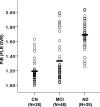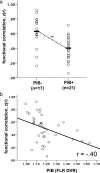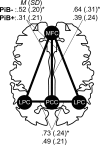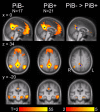Disruption of functional connectivity in clinically normal older adults harboring amyloid burden - PubMed (original) (raw)
Disruption of functional connectivity in clinically normal older adults harboring amyloid burden
Trey Hedden et al. J Neurosci. 2009.
Abstract
Amyloid deposition is present in 20-50% of nondemented older adults yet the functional consequences remain unclear. The current study found that amyloid accumulation is correlated with functional disruption of the default network as measured by intrinsic activity correlations. Clinically normal participants (n = 38, aged 60-88 years) were characterized using (11)C-labeled Pittsburgh Compound B positron emission tomography imaging to estimate fibrillar amyloid burden and, separately, underwent functional magnetic resonance imaging (fMRI). The integrity of the default network was estimated by correlating rest-state fMRI time courses extracted from a priori regions including the posterior cingulate, lateral parietal, and medial prefrontal cortices. Clinically normal participants with high amyloid burden displayed significantly reduced functional correlations within the default network relative to participants with low amyloid burden. These reductions were also observed when amyloid burden was treated as a continuous, rather than a dichotomous, measure and when controlling for age and structural atrophy. Whole-brain analyses initiated by seeding the posterior cingulate cortex, a region of high amyloid burden in Alzheimer's disease, revealed significant disruption in the default network including functional disconnection of the hippocampal formation.
Figures
Figure 1.
Amyloid deposition in clinically normal, MCI, and AD individuals. The DVR for PiB binding in an aggregate region (the FLR region) is plotted for each individual. The present sample of clinically normal older adults (CN) was compared with preexisting samples of MCI participants and AD patients. Means are indicated by black bars. Differences among all group comparisons were significant at p < 0.005.
Figure 2.
The default network is functionally disrupted in clinically normal older adults harboring amyloid burden. a, Default network correlations for clinically normal older adults with (PiB+) and without (PiB−) substantial amyloid burden. Each value represents the mean of the _z_-transformed correlation values between a priori regions of interest in the posterior cingulate, lateral parietal, and medial prefrontal cortices. Black bars indicate the group mean. **p < 0.001. b, Default network correlations plotted against amyloid retention in clinically normal older adults. Amyloid deposition (DVR in an aggregate region of interest—the FLR region) was treated as a continuous measure. A significant negative relationship was observed between amyloid burden and default network correlations (p < 0.02).
Figure 3.
Functional correlations between individual regions are reduced within the default network. Regions of interest in the PCC, LPC, and MPFC were defined a priori and examined for differences in _z_-transformed correlation values between clinically normal individuals with (PiB+) and without (PiB−) substantial amyloid burden. Comparisons involving the lateral parietal regions were averaged across the left and right regions. *p < 0.01.
Figure 4.
Exploratory whole-brain analyses confirm disruption of the default network including the hippocampal formation. Maps display regions that are significantly (cluster-corrected threshold of p < 0.05) correlated with a seed placed in the posterior cingulate cortex (shown in blue) for clinically normal participants with (PiB+) and without (PiB−) substantial amyloid burden. The third column displays regions with significantly greater functional correlations in the PiB− than in the PiB+ group. Regions displaying group differences included lateral parietal and medial prefrontal cortices, as well as bilateral regions within the hippocampal formation (family-wise error correction of _p_ < 0.05 corresponding to _p_ < 0.005 in conjunction with a cluster constraint _k_ > 136).
Similar articles
- Regional amyloid burden and intrinsic connectivity networks in cognitively normal elderly subjects.
Lim HK, Nebes R, Snitz B, Cohen A, Mathis C, Price J, Weissfeld L, Klunk W, Aizenstein HJ. Lim HK, et al. Brain. 2014 Dec;137(Pt 12):3327-38. doi: 10.1093/brain/awu271. Epub 2014 Sep 29. Brain. 2014. PMID: 25266592 Free PMC article. - Covarying alterations in Aβ deposition, glucose metabolism, and gray matter volume in cognitively normal elderly.
Oh H, Habeck C, Madison C, Jagust W. Oh H, et al. Hum Brain Mapp. 2014 Jan;35(1):297-308. doi: 10.1002/hbm.22173. Epub 2012 Sep 11. Hum Brain Mapp. 2014. PMID: 22965806 Free PMC article. - Amyloid and its association with default network integrity in Alzheimer's disease.
Adriaanse SM, Sanz-Arigita EJ, Binnewijzend MA, Ossenkoppele R, Tolboom N, van Assema DM, Wink AM, Boellaard R, Yaqub M, Windhorst AD, van der Flier WM, Scheltens P, Lammertsma AA, Rombouts SA, Barkhof F, van Berckel BN. Adriaanse SM, et al. Hum Brain Mapp. 2014 Mar;35(3):779-91. doi: 10.1002/hbm.22213. Epub 2012 Dec 14. Hum Brain Mapp. 2014. PMID: 23238869 Free PMC article. - Sex differences in functional and molecular neuroimaging biomarkers of Alzheimer's disease in cognitively normal older adults with subjective memory complaints.
Cavedo E, Chiesa PA, Houot M, Ferretti MT, Grothe MJ, Teipel SJ, Lista S, Habert MO, Potier MC, Dubois B, Hampel H; INSIGHT-preAD Study Group; Alzheimer Precision Medicine Initiative (APMI). Cavedo E, et al. Alzheimers Dement. 2018 Sep;14(9):1204-1215. doi: 10.1016/j.jalz.2018.05.014. Epub 2018 Jul 7. Alzheimers Dement. 2018. PMID: 30201102 Review. - The role of the posterior cingulate cortex in cognition and disease.
Leech R, Sharp DJ. Leech R, et al. Brain. 2014 Jan;137(Pt 1):12-32. doi: 10.1093/brain/awt162. Epub 2013 Jul 18. Brain. 2014. PMID: 23869106 Free PMC article. Review.
Cited by
- Functional brain connectivity and cognition: effects of adult age and task demands.
Chou YH, Chen NK, Madden DJ. Chou YH, et al. Neurobiol Aging. 2013 Aug;34(8):1925-34. doi: 10.1016/j.neurobiolaging.2013.02.012. Epub 2013 Mar 21. Neurobiol Aging. 2013. PMID: 23523269 Free PMC article. - Interregional correlations in Parkinson disease and Parkinson-related dementia with resting functional MR imaging.
Seibert TM, Murphy EA, Kaestner EJ, Brewer JB. Seibert TM, et al. Radiology. 2012 Apr;263(1):226-34. doi: 10.1148/radiol.12111280. Epub 2012 Feb 27. Radiology. 2012. PMID: 22371611 Free PMC article. - [Novel methods for dementia diagnostics].
Wiltfang J. Wiltfang J. Nervenarzt. 2015 Apr;86(4):452-60. doi: 10.1007/s00115-014-4177-5. Nervenarzt. 2015. PMID: 25801947 German. - Plasticity of brain networks in a randomized intervention trial of exercise training in older adults.
Voss MW, Prakash RS, Erickson KI, Basak C, Chaddock L, Kim JS, Alves H, Heo S, Szabo AN, White SM, Wójcicki TR, Mailey EL, Gothe N, Olson EA, McAuley E, Kramer AF. Voss MW, et al. Front Aging Neurosci. 2010 Aug 26;2:32. doi: 10.3389/fnagi.2010.00032. eCollection 2010. Front Aging Neurosci. 2010. PMID: 20890449 Free PMC article. - Cognitive Normal Older Adults with APOE-2 Allele Show a Distinctive Functional Connectivity Pattern in Response to Cerebral Aβ Deposition.
Wang SM, Kang DW, Um YH, Kim S, Kim REY, Kim D, Lee CU, Lim HK. Wang SM, et al. Int J Mol Sci. 2023 Jul 8;24(14):11250. doi: 10.3390/ijms241411250. Int J Mol Sci. 2023. PMID: 37511008 Free PMC article.
References
- Aizenstein HJ, Nebes RD, Saxton JA, Price JC, Mathis CA, Tsopelas ND, Ziolko SK, James JA, Snitz BE, Houck PR, Bi W, Cohen AD, Lopresti BJ, DeKosky ST, Halligan EM, Klunk WE. Frequent amyloid deposition without significant cognitive impairment among the elderly. Arch Neurol. 2008;65:1509–1517. - PMC - PubMed
- Ashburner J, Friston KJ. Voxel-based morphometry—the methods. Neuroimage. 2000;11:805–821. - PubMed
- Bacskai BJ, Frosch MP, Freeman SH, Raymond SB, Augustinack JC, Johnson KA, Irizarry MC, Klunk WE, Mathis CA, Dekosky ST, Greenberg SM, Hyman BT, Growdon JH. Molecular imaging with Pittsburgh Compound B confirmed at autopsy: a case report. Arch Neurol. 2007;64:431–434. - PubMed
- Birn RM, Diamond JB, Smith MA, Bandettini PA. Separating respiratory-variation-related fluctuations from neuronal-activity-related fluctuations in fMRI. Neuroimage. 2006;31:1536–1548. - PubMed
Publication types
MeSH terms
Substances
Grants and funding
- AG-021910/AG/NIA NIH HHS/United States
- R01 AG027435/AG/NIA NIH HHS/United States
- P50 AG005134/AG/NIA NIH HHS/United States
- HHMI/Howard Hughes Medical Institute/United States
- R01 AG021910/AG/NIA NIH HHS/United States
- R01 AG034556/AG/NIA NIH HHS/United States
- P50AG005134/AG/NIA NIH HHS/United States
- AG-027435-S1/AG/NIA NIH HHS/United States
LinkOut - more resources
Full Text Sources
Medical



